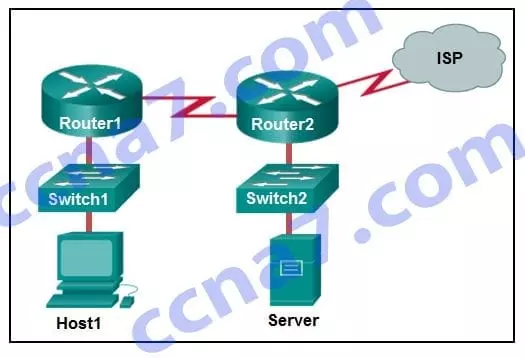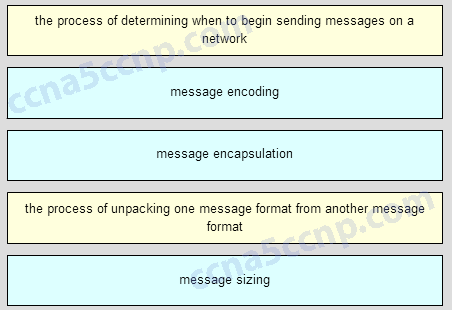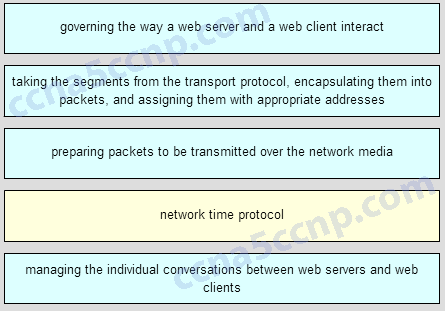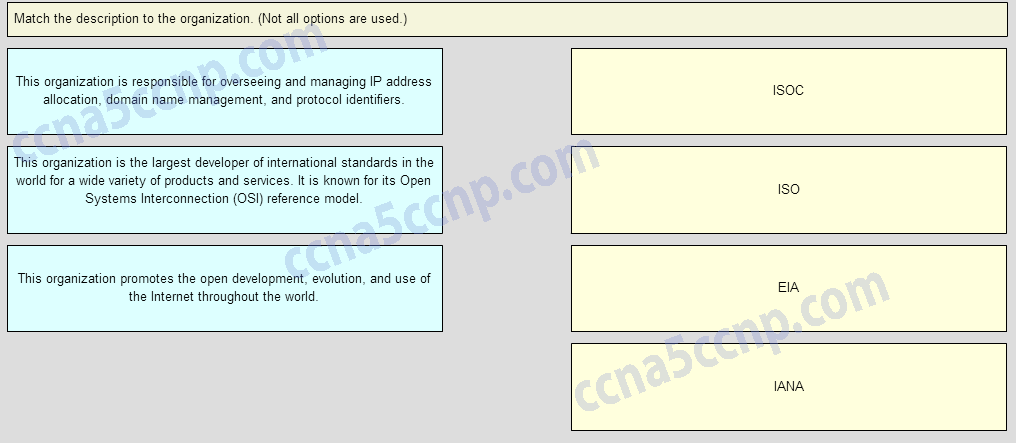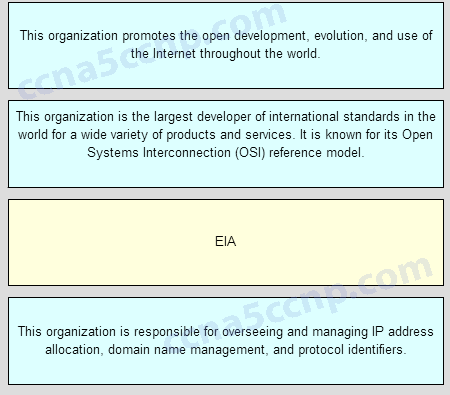Last Updated on January 28, 2021 by Admin
ITN CCNA 1 v6.0 Chapter 3 Exam Answers 2018 2019
Cisco CCNA 1 ITN v6.0 chapter 3 Exam Answers Routing and Switching (R&S) Introduction to Networks (ITN) (Version 6.00) collection year 2017, 2018 and 2019 Full 100%. CCNA 1 has been know as ITN. The following are the questions exam answers. Guarantee Passed 100%. CCNA 1 v6.0 chapter 3 exam answers has some new update from the old version 5.1. You can review all chapter 3 Exam Answers. You will get passed scored 100% with this version 6.0. Good Luck for Cisco Netacad ITN v6.0 Exam!
From year to year, Cisco has updated many versions with difference questions. The latest version is version 6.0 in 2018. What is your version? It depends on your instructor creating your class. We recommend you to go thought all version if you are not clear. While you take online test with netacad.com, You may get random questions from all version. Each version have 1 to 10 different questions or more. After you review all questions, You should practice with our online test system by go to "Online Test" link below.
| Version 5.02 | Version 5.1 | Version 6.0 | Online Assessment |
| Chapter 3 Exam | Chapter 3 Exam | Chapter 3 Exam | Online Test |
| Next Chapter | |||
| Chapter 4 Exam | Chapter 4 Exam | Chapter 4 Exam | Online Test |
| Lab Activities | |||
| 3.2.4.6 Packet Tracer – Investigating the TCP-IP and OSI Models in Action | |||
-
What method can be used by two computers to ensure that packets are not dropped because too much data is being sent too quickly?
- encapsulation
- flow control
- access method
- response timeout
Explanation: In order for two computers to be able to communicate effectively, there must be a mechanism that allows both the source and destination to set the timing of the transmission and receipt of data. Flow control allows for this by ensuring that data is not sent too fast for it to be received properly.
-
What type of communication will send a message to all devices on a local area network?
- broadcast
- multicast
- unicast
- allcast
Explanation: Broadcast communication is a one-to-all communication. A unicast communication is a one-to-one communication. Multicast is a one-to-many communication where the message is delivered to a specific group of hosts. Allcast is not a standard term to describe message delivery.
-
What process is used to place one message inside another message for transfer from the source to the destination?
- access control
- decoding
- encapsulation
- flow control
Explanation: Encapsulation is the process of placing one message format into another message format. An example is how a packet is placed in its entirety into the data field as it is encapsulated into a frame.
-
A web client is sending a request for a webpage to a web server. From the perspective of the client, what is the correct order of the protocol stack that is used to prepare the request for transmission?
- HTTP, IP, TCP, Ethernet
- HTTP, TCP, IP, Ethernet
- Ethernet, TCP, IP, HTTP
- Ethernet, IP, TCP, HTTP
Explanation: 1. HTTP governs the way that a web server and client interact.
2. TCP manages individual conversations between web servers and clients.
3. IP is responsible for delivery across the best path to the destination.
4. Ethernet takes the packet from IP and formats it for transmission.
-
Which statement is correct about network protocols?
- Network protocols define the type of hardware that is used and how it is mounted in racks.
- They define how messages are exchanged between the source and the destination.
- They all function in the network access layer of TCP/IP.
- They are only required for exchange of messages between devices on remote networks.
Explanation: Network protocols are implemented in hardware, or software, or both. They interact with each other within different layers of a protocol stack. Protocols have nothing to do with the installation of the network equipment. Network protocols are required to exchange information between source and destination devices in both local and remote networks.
-
Which statement is true about the TCP/IP and OSI models?
- The TCP/IP transport layer and OSI Layer 4 provide similar services and functions.
- The TCP/IP network access layer has similar functions to the OSI network layer.
- The OSI Layer 7 and the TCP/IP application layer provide identical functions.
- The first three OSI layers describe general services that are also provided by the TCP/IP internet layer.
Explanation: The TCP/IP internet layer provides the same function as the OSI network layer. The transport layer of both the TCP/IP and OSI models provides the same function. The TCP/IP application layer includes the same functions as OSI Layers 5, 6, and 7.
-
What is an advantage of using standards to develop and implement protocols?
- A particular protocol can only be implemented by one manufacturer.
- Products from different manufacturers can interoperate successfully.
- Different manufacturers are free to apply different requirements when implementing a protocol.
- Standards provide flexibility for manufacturers to create devices that comply with unique requirements.
Explanation: The TCP/IP internet layer provides the same function as the OSI network layer. The transport layer of both the TCP/IP and OSI models provides the same function. The TCP/IP application layer includes the same functions as OSI Layers 5, 6, and 7.
-
What three application layer protocols are part of the TCP/IP protocol suite? (Choose three.)
- ARP
- DHCP
- DNS
- FTP
- NAT
- PPP
Explanation: DNS, DHCP, and FTP are all application layer protocols in the TCP/IP protocol suite. ARP and PPP are network access layer protocols, and NAT is an internet layer protocol in the TCP/IP protocol suite.
-
What are proprietary protocols?
- protocols developed by private organizations to operate on any vendor hardware
- protocols that can be freely used by any organization or vendor
- protocols developed by organizations who have control over their definition and operation
- a collection of protocols known as the TCP/IP protocol suite
Explanation: Proprietary protocols have their definition and operation controlled by one company or vendor. Some of them can be used by different organizations with permission from the owner. The TCP/IP protocol suite is an open standard, not a proprietary protocol.
-
What is an advantage of network devices using open standard protocols?
- Network communications is confined to data transfers between devices from the same vendor.
- A client host and a server running different operating systems can successfully exchange data.
- Internet access can be controlled by a single ISP in each market.
- Competition and innovation are limited to specific types of products.
Explanation: An advantage of network devices implementing open standard protocols, such as from the TCP/IP suite, is that clients and servers running different operating systems can communicate with each other. Open standard protocols facilitate innovation and competition between vendors and across markets, and can reduce the occurrence of monopolies in networking markets.
-
Refer to the exhibit. If Host1 were to transfer a file to the server, what layers of the TCP/IP model would be used?
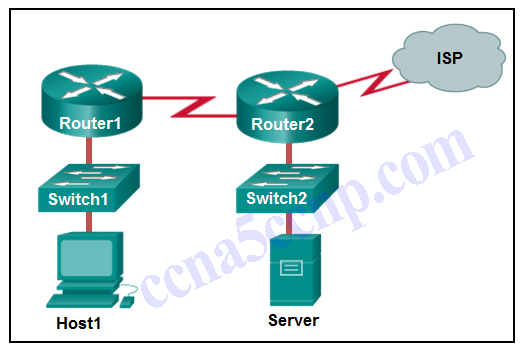
Cisco ITN CCNA 1 v6.0 Chapter 3 Exam Answer R&S 2018 2019 001
- only application and Internet layers
- only Internet and network access layers
- only application, Internet, and network access layers
- application, transport, Internet, and network access layers
- only application, transport, network, data link, and physical layers
- application, session, transport, network, data link, and physical layers
Explanation: The TCP/IP model contains the application, transport, internet, and network access layers. A file transfer uses the FTP application layer protocol. The data would move from the application layer through all of the layers of the model and across the network to the file server.
-
Which three layers of the OSI model are comparable in function to the application layer of the TCP/IP model? (Choose three.)
- application
- presentation
- session
- transport
- data link
- physical
- network
Explanation: The TCP/IP model consists of four layers: application, transport, internet, and network access. The OSI model consists of seven layers: application, presentation, session, transport, network, data link, and physical. The top three layers of the OSI model: application, presentation, and session map to the application layer of the TCP/IP model.
-
At which layer of the OSI model would a logical address be encapsulated?
- physical layer
- data link layer
- network layer
- transport layer
Explanation: Logical addresses, also known as IP addresses, are added at the network layer. Physical addresses are edded at the data link layer. Port addresses are added at the transport layer. No addresses are added at the physical layer.
-
Which PDU format is used when bits are received from the network medium by the NIC of a host?
- file
- frame
- packet
- segment
Explanation: When received at the physical layer of a host, the bits are formatted into a frame at the data link layer. A packet is the PDU at the network layer. A segment is the PDU at the transport layer. A file is a data structure that may be used at the application layer.
-
Which PDU is processed when a host computer is de-encapsulating a message at the transport layer of the TCP/IP model?
- bits
- frame
- packet
- segment
Explanation: At the transport layer, a host computer will de-encapsulate a segment to reassemble data to an acceptable format by the application layer protocol of the TCP/IP model.
-
Refer to the exhibit. HostA is attempting to contact ServerB. Which two statements correctly describe the addressing that HostA will generate in the process? (Choose two.)
- A packet with the destination IP address of RouterB.
- A frame with the destination MAC address of SwitchA.
- A packet with the destination IP address of RouterA.
- A frame with the destination MAC address of RouterA.
- A packet with the destination IP address of ServerB.
- A frame with the destination MAC address of ServerB.
Explanation: In order to send data to ServerB, HostA will generate a packet that contains the IP address of the destination device on the remote network and a frame that contains the MAC address of the default gateway device on the local network.
-
Which address does a NIC use when deciding whether to accept a frame?
- source IP address
- source MAC address
- destination IP address
- destination MAC address
- source Ethernet address
-
What will happen if the default gateway address is incorrectly configured on a host?
- The host cannot communicate with other hosts in the local network.
- The switch will not forward packets initiated by the host.
- The host will have to use ARP to determine the correct address of the default gateway.
- The host cannot communicate with hosts in other networks.
- A ping from the host to 127.0.0.1 would not be successful.
Explanation: When a host needs to send a message to another host located on the same network, it can forward the message directly. However, when a host needs to send a message to a remote network, it must use the router, also known as the default gateway. This is because the data link frame address of the remote destination host cannot be used directly. Instead, the IP packet has to be sent to the router (default gateway) and the router will forward the packet toward its destination. Therefore, if the default gateway is incorrectly configured, the host can communicate with other hosts on the same network, but not with hosts on remote networks.
-
Which characteristic describes the default gateway of a host computer?
- the logical address of the router interface on the same network as the host computer
- the physical address of the switch interface connected to the host computer
- the physical address of the router interface on the same network as the host computer
- the logical address assigned to the switch interface connected to the router
Explanation: The default gateway is the IP address of an interface on the router on the same network as the sending host.
-
Match each description to its corresponding term. (Not all options are used.)
- Question
- Answer
-
Match the protocol function to the description while taking into consideration that a network client is visiting a web site. (Not all options are used.)
- Question
- Answer
Explanation: When a web client visits a web server, several network communication protocols are involved. These different protocols work together to ensure that the messages are received and understood by both parties. These protocols include the following:
- Application Protocol – governing the way a web server and a web client interact
- Transport Protocol – managing the individual conversations between web servers and web clients
- Internet Protocol – taking the formatted segments from the transport protocol, encapsulating them into packets, assigning them the appropriate addresses, and delivering them across the best path to the destination host
- Network Access Protocol – preparing packets to be transmitted over the network media
Network Time Protocol is used to synchronize clocks between computer systems. It is not involved in this case.
-
Match the description to the organization. (Not all options are used.)
- Question
- Answer
Explanation: The EIA is an international standards and trade organization for electronics organizations. It is best known for its standards related to electrical wiring, connectors, and the 19-inch racks used to mount networking equipment.
From year to year, Cisco has updated many versions with difference questions. The latest version is version 6.0 in 2018. What is your version? It depends on your instructor creating your class. We recommend you to go thought all version if you are not clear. While you take online test with netacad.com, You may get random questions from all version. Each version have 1 to 10 different questions or more. After you review all questions, You should practice with our online test system by go to "Online Test" link below.
| Version 5.02 | Version 5.1 | Version 6.0 | Online Assessment |
| Chapter 3 Exam | Chapter 3 Exam | Chapter 3 Exam | Online Test |
| Next Chapter | |||
| Chapter 4 Exam | Chapter 4 Exam | Chapter 4 Exam | Online Test |
| Lab Activities | |||
| 3.2.4.6 Packet Tracer – Investigating the TCP-IP and OSI Models in Action | |||
